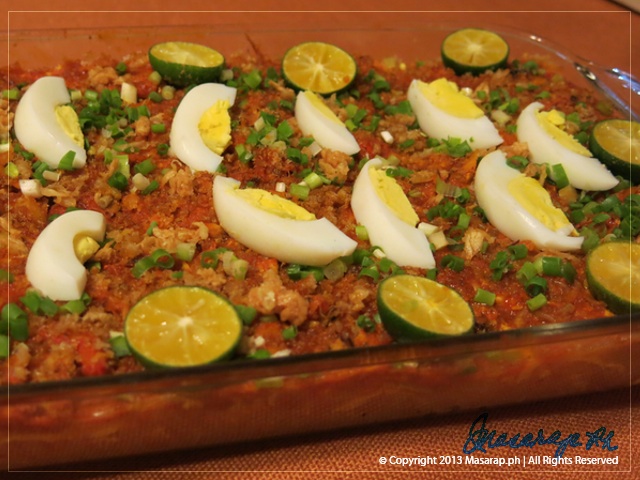
The most popular pancit that we serve and sell is called Pancit Luglug. It’s not only popular with us, but in most Filipino restaurants, this is a best seller. Because thin rice noodles are used, it’s light and bright! BUT, it’s very time consuming to make because it has so many ingredients, thus the term ‘palabok’ (flowery or flamboyant). But because it is so delicious,  every morsel and mouthful is well worth in making  the effort. Luglug refers to the technique used in cooking the thin rice noodles; one just quickly dips it in boiling broth for 3 seconds. The good thing with Pancit Luglug, one can also eat it cold and it will still taste good. Then, there are those like my daughter, who likes to eat this at room temperature.Â
Topping:
- 1/4 cup cooking oil
- 2 tablespoons finely minced garlic
- 1/2 cup finely chopped onions
- 1 tablespoon anato liquid – to extract anato liquid, get 1 tablespoon of anato (atswete) seeds. Mix anato with 1/2 teaspoon liquid lye. Leave for 1 hour. Pour 1/2 cup of boiling water and mix well. Leave for 30 minutes; strain out the seeds and use liquid. Use the balance for the sauce. In the Philippine market, one can get anato seeds that have lye mixed with it. In other countries, one can find anato/atswete powder (follow instructions on package)
- 250 grams shrimps – steam to cook, peel and cube – save shrimp heads, set aside
- 250 grams blue swimmer crabs (alimasag) – steam to cook and peel to get meat (you can also use the canned or frozen variety)
- 1/4 kilo pork belly – boil till tender; slice into 1/4-inch thick strips
- 1 teaspoon salt
- 1/4 teaspoon freshly ground black pepper
Topping Preparation
- In a medium sized frying pan, over low fire, pour in cooking oil and saute the garlic till a light golden tan.
- Remove half of the sauteed garlic and place over kitchen paper towel to drain. This is to be used for garnishing.
- Add the onions and continue to saute till the onions are translucent.
- Pour in the anato/atswete liquid and simmer for 5 minutes.
- Add shrimps, crab and pork and simmer for another 5 minutes.
- Season with salt and pepper.
- Set aside.
Sauce Ingredients:
- 1 tablespoon cooking oil
- 1 teaspoon finely crushed garlic
- 1/4 cup finely chopped onions
- 2 tablespoons atswete liquid
- 1 tablespoon fish sauce (patis)
- 1 teaspoon salt
- 1/2 teaspoon freshly ground black pepper
- 3 cups chicken broth
- 1/2 cup shrimp head juice – shrimp heads – using a mortar and pestle, pound shrimp heads and place in a small sauce pan; add 3/4 cup water to pan and simmer for 10 minutes then strain out liquid.
- 1/4 cup cornstarch dissolved in 1/4 cup broth (at room temperature)
- 1 whole egg – beaten with fork
Sauce Procedure:
- In a medium sized sauce pan, over low fire, pour in oil and saute garlic and onion till the onions are translucent.
- Add the anato liquid and simmer for 5 minutes or till that metallic smell from the anato is gone.
- Add fish sauce, salt, pepper, shrimp juice, and broth. Simmer for 15 minutes.
- Taste the sauce and adjust to your taste by adding patis or pepper or both.
- Then thicken with the cornstarch mixture; stirring constantly.
- Lastly, add the beaten egg, constantly stirring and well mixed.
- Set aside.
Noodles Ingredients:
- 250 grams bihon noodles (thin rice noodles)
- 8 cups chicken broth
Noodles Procedure:
- Soak the rice noodles in cold water till pliable.
- Do not over soak.
- Drain using a colander.
- Bring the chicken broth to a rolling boil. Use a deep but narrow pot.
- Using a noodle strainer, (the ones used in Chinese cooking), place just a cupful of the bihon and dip into the boiling broth for 3 seconds.
- Do not over cook or the noodles will be sticky and soggy.
- Remove from broth, shake off excess liquid and transfer to serving dish; repeat with the rest of the noodles.
Garnishing Ingredients:
- 1 cup mung bean sprouts (togue) – rinse and remove tails and green mung bean shell
- 1/4 cup finely sliced spring onion in circles
- toasted garlic from the first sauteeing
- 1 egg cooked like an omelette – slice julienne or 1 hard boiled egg sliced into thin circles or into thin half moons
- 1/3 cup chicharon (pork crackling) – chopped coarsely
- 2 tablespoons tinapa (smoked fish) – deboned and flaked and lightly toasted
- 6 pieces calamansi (calamundin) sliced in half and seeded or lemon slices
- fish sauce (patis) on the side
Assembly Procedure:
- On the serving tray where the cooked bihon has been placed, pour half of the sauce on the noodles. Mix well.
- Top with the other half, evenly, all over.
- Scatter the following in order, on top of noodles:
- Topping (shrimp/pork/crab) mixture
- mung beans
- spring onion
- chicharon
- tinapa
- garlic
- egg omelette slices or hard boiled egg slices
- Garnish with calamansi slices.
- Serve with patis on the side
Note:
- Noodles are considered to be a symbol for “long life” in Asian cuisine, hence its inclusion in most festive tables. This is one dish that is truly ‘to live for’! Mabuhay ang Pinoy!

Recent Comments